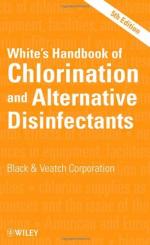|
This section contains 1,218 words (approx. 5 pages at 300 words per page) |

|
Chlorination refers to the application of chlorine for the purposes of oxidation. The forms of chlorine used for chlorination include: chlorine gas, hypochlorous acid (HOCl), hypochlorite ion (OCl), and chloramines or combined chlorine (Mono-, di-, and tri-chloramines). The first three forms of chlorine are known as free chlorine.
Chlorine (Cl) has three valences under normal environmental conditions, -1, 0 and +1. Environmental scientists often refer only to the chlorine forms having 0 and +1 valences as chlorine; they refer to the -1 form as chloride. Chlorine with a valence of 0 (Cl2) and chlorine with a valence of +1 (HOCl) both have the ability to oxidize materials, whereas chlorine at a -1 valence, chloride, is already at its lowest oxidation state and has no oxidizing power.
The functions of chlorination are to disinfect water or wastewater, decolorize waters or fabrics, sanitize and clean surfaces, remove iron and manganese, and reduce odors. The fundamental principle...
|
This section contains 1,218 words (approx. 5 pages at 300 words per page) |

|


